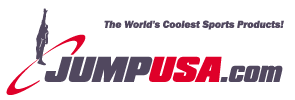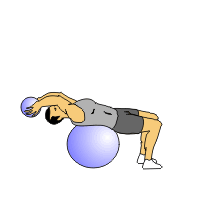
Therapeutic Modalities
Order online or call now:
1-800-JUMP-USA (586-7872)
Mail orders and superstore location
 |
Therapeutic Modalities
|
Order online or call now: 1-800-JUMP-USA (586-7872) Mail orders and superstore location |
|
|
JumpUSA.com Topic #477
Rest
and Recovery: Therapeutic Modalities
(Part 2
of 2) (click to see part 1)
Today the
fitness professional and enthusiast has access to a dizzying array of
methods and options to help speed and maximize recovery
between training sessions, but random application of these
tools (often referred to as "therapeutic modalities") can cause more
harm than good. One modality can not be used exclusively to help with
all aspects of recovery, making it necessary to be familiar with a
variety of methods and their most effective applications. Here are some
of the more common methods and their applications:
Passive
Rest - This refers to rest as most of us think about it. Hard
training individuals will need between 7 and 8 hours of sleep a night
and most would benefit from an additional short nap (30 minutes) during
the day as well. Many things can effect sleeping habits and those who
do not get adequate sleep on a very consistent basis will compromise
their recovery. Sorry folks, there's just no getting around the need
for sleep in order to maximize your fitness potential.
Active
"Rest" - Don't let the word rest fool you here, this actually
refers to using light activity to hasten recovery, most notably your
cool-down period. By taking 10-20 minutes after working out to do some
light aerobic activity and stretch you help to boost your recovery
immediately. Consider this - 10 minutes of light jogging (no more than
60% of estimated max heart rate) will help remove around 60% of the
lactic acid built up in your muscles, another 10 minutes will clear out
an additional 25%.
If you
don't cool-down, it can take up to 4 hours to completely clear the
lactic acid and other metabolic wastes from the muscle tissue.
Stretching helps as well to "wring" the metabolic wastes from the
muscle tissue in addition to helping to restore the muscles to their
normal length.
Besides
your warm-up, active rest also refers to light workouts between heavy
ones and periods of less structured training in a periodized program.
Light activity will speed recovery faster than complete rest alone.
Continued Below... Sport Specific Exercise and Tip of the week! Medicine
Ball Throws on a Swiss Ball - With your back on
a Swiss Ball, throw a medicine ball against a wall or have a partner
toss it to you and toss it back. A great ab, back, and
triceps workout for explosive core movement.
 For Sport
Specific Tips like these that will help you improve and excel in your
sport, visit SportSpecific.com
MEDICINE BALL
BLOWOUT! Save $20 or $25! on 6 or 8 lb. Medicine Balls - 6
lb ($39.95) only $19.95, 8 lb. ($49.95) only $24.95 - get them while
they last!
MEDICINE BALL + SWISS BALL
COMBOS: Save up to $40! 8 lb. Medicine
Ball + Swiss Ball regular $79.90 - only $39.95!
Massage - Massage is perhaps the oldest
method of speeding recovery. It has been used for thousands of years
(at least that's as old as the records go) and is one of the most
accessible and useful methods available. It can be used almost anywhere
and can be applied by the trainee in many cases. Instincts tell us to
rub on a sore or aching bodypart, and for good reason.
Massage can be used to help speed recovery between sets
as well as between training sessions. It is used to increase blood
circulation, reduce muscular fatigue, lower excessive swelling, stretch
muscle adhesions and knots and increase lymphatic circulation. Trainees
should seek a massage at least once every few weeks. Check your area
for massage schools; massage students have to do countless hours of
massage training to receive their certification and most schools will
offer clinics in which people can receive an hour long, full-body
massage for around $30. If available, make sure to take advantage of
massage to help speed your recovery.
Heat (Thermotherapy) - Application of
heat has many forms, from simply taking a hot shower to sophisticated
methods such as ultrasound. Heat will increase the blood flow to the
targeted area (sometimes as much as doubling it) with obvious benefits
for waste removal and speeding the delivery of vital recovery nutrients
(like amino acids and vitamins). Heat should not be used immediately
after training or in the case of acute injury or trauma. Heat should
only be used after the edema has gone down a bit, usually 3-4 days
after the initial injury. Learn more...
Cold (Cryotherapy) - Cold therapy is
another of the more popular and accessible therapeutic modalities. Its
main benefit is localized pain relief without the aid of drugs. Cold
therapy comes in a few forms, most commonly a cold bath or ice.
Applying cold to traumatized tissue will reduce spasms and increase
local blood flow, levels of oxygen and metabolism. For fastest results
it is suggested that you apply the cold immediately after training and
every 20 minutes for no more than 2 hours. Best results are seen in
tissues that require longer regeneration periods like fast-twitch
muscle groups and tendons. Learn more...
Contrast Bath - Best if used before an
injury becomes severe, contrast baths are very effective at reducing
muscle spasms and decreasing pain. The most common theory on why
contrast baths work so well is that the changes between vasodialation
(heat) and vasoconstriction (cold) cause a "pumping" action in the
muscles and helps speed waste removal and nutrient delivery. However it
works, contrast baths are a great tool.
Recommendations include starting and ending with cold,
spending 3-4 times longer on heat treatment compared to cold treatment
and keeping sessions to no longer than 20 minutes in length. Many
options exist for the heat and cold therapy and one combination is not
necessarily better than another.
Acupuncture/Acupressure (Reflexotherapy)
- These modalities are based on the ancient Chinese concept that energy
(chi) flows along channels called meridians through the body. A
disruption of these meridians, either through stress or improper diet,
can interfere with just about every bodily function, including those
that effect recovery. Reflexotherapy is a means of restoring that flow
and promoting healing and harmony in the body. While both methods make
use of key points along the meridians, acupuncture uses needles and
acupressure simply uses direct pressure from the fingers. While western
doctors have been slow to accept these methods, as research and real
world evidence grows it is becoming more and more common and accepted.
Nutrition - While not usually considered
therapeutic, nutrition plays a huge role in the speed and completeness
of recovery. Your body needs raw materials to repair and restore bodily
systems stressed by training and without adequate nutrition those
materials will not be available. Vitamins, minerals, water, protein,
carbs and fats must all be present in proper amounts in order for the
body to fully recover from training. A deficiency in even one key
nutrient could slow this process down greatly, if not grind it to a
complete halt. Proper nutrition can not be stressed enough when talking
about the overall success of a fitness program and most trainees'
frustration about their lack of progress can be traced back to this
recovery factor.
Relaxation Techniques - Stress, as
mentioned earlier, can have some very serious physical manifestations
if left unchecked. Relaxation techniques can help to greatly reduce
stress and minimize these physical problems. Excessive muscle tension
and an increase in catabolic hormones are two of the most common
physical problems that can slow down recovery.
Techniques such as yoga, visual imagery, meditation,
Tai-chi, breathe control and positive self-talk, just to name a few,
have been used by progressive trainers and their clients to reduce
stress related problems and greatly increase recovery.
Intelligent use of a few or (preferably) all of
these therapeutic modalities will result in what has been dubbed by
some "permanent recovery". This is the point where your body
is able to keep up with the demands of your training program and
fatigue is minimized. If permanent recovery is not taking place fatigue
will become more and more of a factor, eventually leading to
overreaching and then the dreaded enemy of gym goers everywhere - overtraining.
info from bodybuilding.com
|